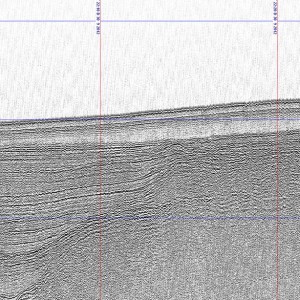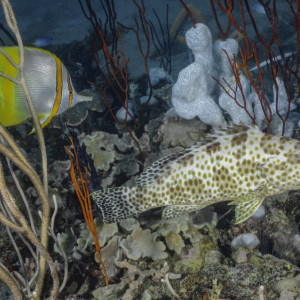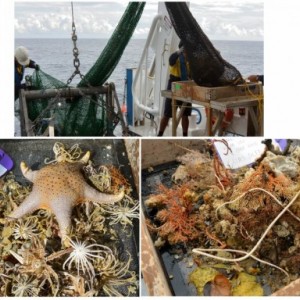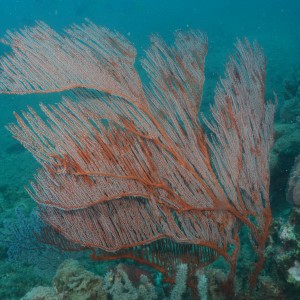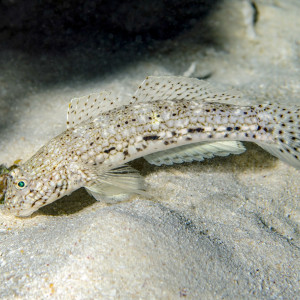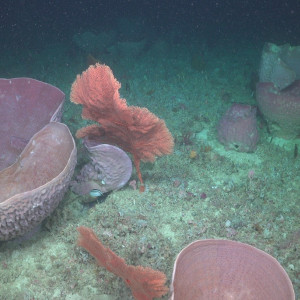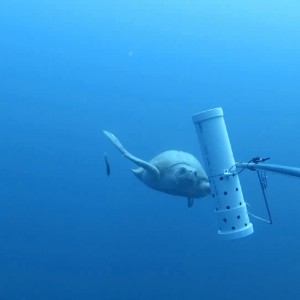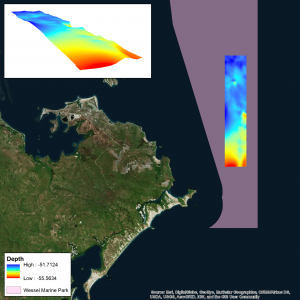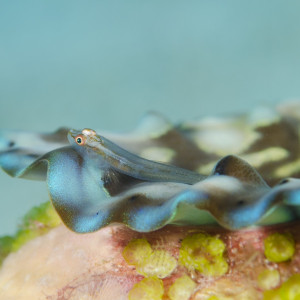A small blenny (Ecsenius yaeyamaensis) on a massive coral. There are over 300 known species of blennies globally, most of which are restricted to tropical regions with only a few found in cool-temperate waters. Blennies are small bottowm-dwelling fish, and this particular species is commonly observed in shallow coastal reefs where it perches on boulders and live coral heads in areas of abundant coral growth.
 by Reef Life Survey
by Reef Life SurveyA screenshot of a sub-bottom profile collected int the Oceanic Shoals Marine Park. It shows a layered sediment (mud and sand) that has partly buried by a carbonate bank (bottom right corner). The length of the image is approximately 7.5 km, and the depth of the ocean floor is 100 m.
 by Geoscience Australia
by Geoscience AustraliaAreolate grouper (Epinephelus areolatus) hides amongst the jumble of sessile invertebrates in the North Marine Parks Network.
 by Graham Edgar
by Graham EdgarExamples of what was found in the benthic sleds. Top: RV Solander crew release the sample from the sled net into the sorting tray on deck. Left: A sled dominated by feather stars, brittle stars and sea stars. Right: A sled dominated by sponges and soft corals
Giant basket sponge (Xestospongia testudinaria) on reef in Carpentaria Marine Park
 by Reef Life Survey
by Reef Life SurveyReef animals including gorgonians at Carpentaria Reef, Carpentaria Marine Park
 by Reef Life Survey
by Reef Life SurveyReef animals including gorgonians at Carpentaria Reef, Carpentaria Marine Park
 by Reef Life Survey
by Reef Life SurveyIstigobius decoratus, known as the Decorated Sandgoby is found on sand patches near reefs.
 by Ian Shaw
by Ian ShawSponge communities in the mesophotic zone at Ashmore Reef Marine Park
 by Schmidt Ocean Institute / AIMS
by Schmidt Ocean Institute / AIMSThis Olive Rideley (Lepidochelys olivacea) turtle was photographed during a BRUVS survey in the Oceanic Shoals Marine Park in September 2012. Olive Ridely turtles are one of the most abundant species of sea turtles globally, however they are considered Vulnerable by the IUCN Red List of Threatened Species, and listed as Endangered under the Australian EPBC Act. Their listing is due to significant declines in global populations. In Australia few surveys on this species have been conducted, and we still have a lot to learn about where these turtles, their population size, distribution and behaviour.
 by UWA - Centre for Marine Futures
by UWA - Centre for Marine FuturesOutput spline with 3D surface render of the areas surveyed in the Wessel Marine Park during RV Solander Trip 7084
Pleurosicya mossambica also known as the toothy goby or the Mozambique ghost goby is found on many substrates, including corals, sponges, giant clams and seaweeds, and can vary colour according to the substrate.
 by Ian Shaw
by Ian ShawSea snake (Aipysurus laevis) on Carpentaria Reef in the Gulf of Carpentaria Marine Park.
 by Reef Life Survey
by Reef Life SurveySoft coral on Carpentaria Shoal in the Gulf of Carpentaria Marine Park.
 by Reef Life Survey
by Reef Life SurveyThese striped catfish (Plotosus lineatus) were photographed in the the Arafura Marine Park during a survey by Reef Life Survey. This is the only catfish that is found in coral reef ecosystems, however they are also found on the open coast and in tide pools. Juveniles of this species are typically found in balls of about 100 individuals like in this photograph, while adults are solitary or occur in much smaller groups.
 by Reef Life Survey
by Reef Life SurveyPreparing for Reef Life Surveys with Gumurr Marthakal Rangers near Elcho Island.
 by Reef Life Survey
by Reef Life SurveyWhite seawhip (Junceella fragilis) with schooling fish on a reef in Arnhem Marine Park.
 by Reef Life Survey
by Reef Life Survey
